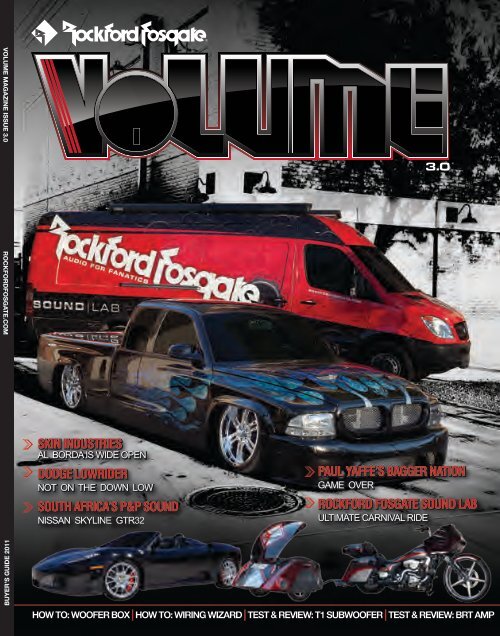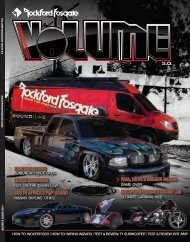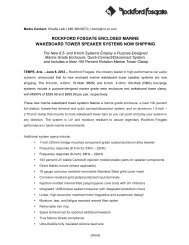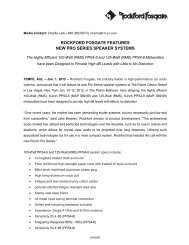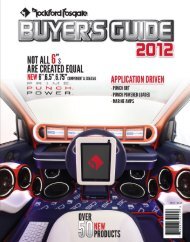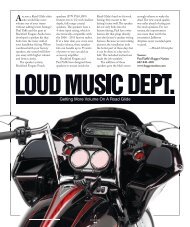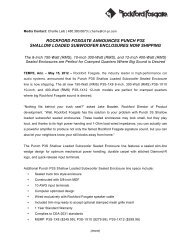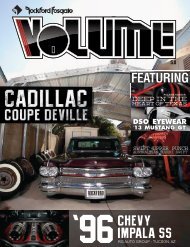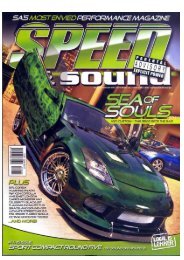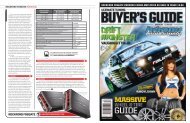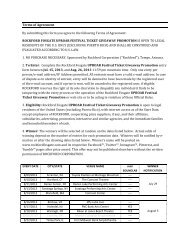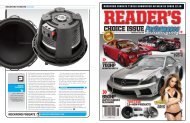Letter from the President and CEO - Rockford Fosgate
Letter from the President and CEO - Rockford Fosgate
Letter from the President and CEO - Rockford Fosgate
Create successful ePaper yourself
Turn your PDF publications into a flip-book with our unique Google optimized e-Paper software.
Volume MAGAZINE ISSUE 3.0<br />
rockfordfosgate.com<br />
Skin Industries<br />
al borda is wide open<br />
dodge lowrider<br />
not on <strong>the</strong> down low<br />
south africa’s p&p sound<br />
Nissan skyline skyle gtr32<br />
paul Yaffe’s bagger nation<br />
game over<br />
rockford fosgate sound lab<br />
ultimate carnival ride<br />
buyer’s guide 2011<br />
How To: Woofer Box | How To: Wiring wizard | test & Review: t1 subwoofer | test & Review: brt amp
yan sipes<br />
josh grant<br />
<strong>Letter</strong> <strong>from</strong> <strong>the</strong> <strong>President</strong> <strong>and</strong> <strong>CEO</strong><br />
People often ask me, “What makes <strong>Rockford</strong> <strong>Fosgate</strong> so special? Isn’t it<br />
just ano<strong>the</strong>r car audio product?” My answer is simple. <strong>Rockford</strong> <strong>Fosgate</strong><br />
is <strong>the</strong> “original seed” of car audio. In 1973, Jim <strong>Fosgate</strong> was a visionary<br />
in designing a high power amplifier for <strong>the</strong> automobile. From that point<br />
forward <strong>Rockford</strong> <strong>Fosgate</strong> has set <strong>the</strong> benchmark in mobile audio <strong>and</strong><br />
defined <strong>the</strong> lifestyle.<br />
It’s about <strong>the</strong> music <strong>and</strong> <strong>the</strong> experience in <strong>the</strong> car. I recently drove home <strong>from</strong><br />
<strong>the</strong> office <strong>and</strong> sat in <strong>the</strong> driveway listening to <strong>the</strong> end of an old Steely Dan<br />
album. Not only did it bring back some great memories, but I was immersed<br />
in <strong>the</strong> performance. Great car audio has <strong>the</strong> ability to insert you into <strong>the</strong><br />
performance <strong>and</strong> <strong>the</strong> music. You feel it, you hear it, it becomes emotional,<br />
<strong>and</strong> it makes you respond. It’s this experience we have brought to <strong>the</strong><br />
marketplace with our Sound LAB vehicles. People get to experience car<br />
audio <strong>the</strong> <strong>Rockford</strong> <strong>Fosgate</strong> way in <strong>the</strong> PRESSURE CHAMBER or demo our<br />
various products in <strong>the</strong>ir own vehicles via <strong>the</strong> LAB. The results are just like<br />
my ride home, WOW!<br />
It doesn’t matter whe<strong>the</strong>r you are listening to Lady Gaga, AC/DC or Robbie<br />
Williams, <strong>the</strong> performance becomes “personal”. The lifestyle that goes along<br />
with <strong>Rockford</strong> <strong>Fosgate</strong> is honest <strong>and</strong> straight forward. We are passionate,<br />
we like quality <strong>and</strong> we are proud of our rides. We take cars <strong>and</strong> car audio<br />
seriously. If you walk <strong>the</strong> halls of <strong>the</strong> corporate office in Tempe, you will find<br />
CAR AUDIO FANATICS. We live this business, Period!<br />
cameron dollar<br />
From each <strong>and</strong> every person at <strong>Rockford</strong>, thank you for your interest <strong>and</strong><br />
support. We remain committed to developing class leading mobile electronic<br />
products. Enjoy <strong>the</strong> <strong>Rockford</strong> <strong>Fosgate</strong> experience <strong>and</strong> remember it’s all about<br />
<strong>the</strong> music in your car!<br />
Bill Jackson, <strong>President</strong>/<strong>CEO</strong><br />
1 VOLUME 3.0<br />
ROCKFORDFOSGATE.COM 2
features<br />
25<br />
15<br />
21<br />
7<br />
7 // rockford fosgate sound lab<br />
ultimate carnival ride<br />
15 // Skin Industries<br />
al borda is wide open<br />
21 // south africa’s p&p sound<br />
Nissan skyline gtr34<br />
27<br />
departments<br />
9 // test & review - boosted rail amplifier<br />
11 // how to - woofer wiring wizard<br />
13 // inside look - T5 components<br />
17 // inside look - boosted rail amplifier<br />
19 // test & review - t1 subwoofers<br />
3 VOLUME 3.0<br />
25 // paul Yaffe’s bagger nation<br />
game over<br />
27 // dodge lowrider<br />
not on <strong>the</strong> down low<br />
22 // how to - do it yourself box build<br />
23 // inside look - power ad amplifier<br />
29 // inside look - 3sixty.3 processor<br />
31 // rockford fosgate punch wear<br />
P3<br />
UNSURPASSED INTENSITY<br />
WITH A RELENTLESS PUNCH<br />
INNOVATION & DESIGN<br />
EXCEEDING ALL EXPECTATIONS<br />
25 %<br />
MORE<br />
CONE AREA<br />
Vertical Attach Surround Technique<br />
U.S. Patent (Patent Pending)<br />
PUNCH P3 Subwoofers Feature:<br />
• VAST provides up to a 25% increase in <strong>the</strong> speakers<br />
effective radiating cone area dramatically improving both<br />
nominal efficiency <strong>and</strong> maximum output capabilities.<br />
• Flex Fit is a slot mounted frame pattern which allows slight<br />
adjustment of <strong>the</strong> speaker when mounted.<br />
• 2.5” Copper Clad Aluminum Voice Coil<br />
• Thermal Anodized Aluminum Cone<br />
• 500-600 watts RMS/1000-1200 watts Peak<br />
AVAILABILE:<br />
- 10”, 12”, 15” Sizes<br />
- Dual 2 or 4 ohm<br />
<strong>Rockford</strong> <strong>Fosgate</strong> PUNCH ® subwoofers, available at authorized retailers worldwide rockfordfosgate.com • 800.366.2349
setting<br />
<strong>the</strong><br />
st<strong>and</strong>ard<br />
In 1973, Jim <strong>Fosgate</strong> changed <strong>the</strong> rules of <strong>the</strong> game when he<br />
designed an amplifier called <strong>the</strong> POWERPUNCH. <strong>Fosgate</strong><br />
had engineered <strong>and</strong> designed an amplifier that for <strong>the</strong> first<br />
time in history could drive low impedance loads <strong>and</strong> was<br />
able to run both stereo <strong>and</strong> mono simultaneously. This<br />
dictated that <strong>the</strong> amplifier incorporated a MOSFET design,<br />
a small detail that was unknown in <strong>the</strong> world of audio. With<br />
this unique amplifier design <strong>Fosgate</strong> <strong>the</strong>n designed <strong>the</strong><br />
Punch EQ, allowing <strong>the</strong> adjustability to <strong>the</strong> bass <strong>and</strong><br />
treble, <strong>the</strong> sonic signature or “curves”. This allowed <strong>the</strong><br />
perfect balance <strong>and</strong> Punch that was needed in a car audio<br />
system. The dynamic sound of <strong>the</strong> Punch EQ would lead<br />
an industry for over three decades by a mastermind of<br />
engineering, design, innovation <strong>and</strong> technology. <strong>Fosgate</strong><br />
became an industry icon <strong>and</strong> comm<strong>and</strong>ed <strong>the</strong> authority of<br />
Power <strong>and</strong> Performance, a br<strong>and</strong> for a lifestyle that would<br />
bond those passionate about high performance car audio.<br />
Today <strong>Rockford</strong> <strong>Fosgate</strong> has manufactured, serviced <strong>and</strong><br />
supported an industry worldwide <strong>and</strong> has come to define<br />
high performance car audio. A long-st<strong>and</strong>ing reputation of<br />
exceptional products, reliability <strong>and</strong> assurance has earned<br />
<strong>Rockford</strong> <strong>Fosgate</strong> <strong>the</strong> prominent position in <strong>the</strong> audio<br />
industry. Just as our products have evolved, so too has our<br />
company. We continue to lead <strong>and</strong> are proud to design<br />
<strong>and</strong> engineer in <strong>the</strong> USA. We pledge that every product<br />
that embraces <strong>the</strong> name <strong>Rockford</strong> <strong>Fosgate</strong> is backed by<br />
an extensive <strong>and</strong> dependable worldwide support network.<br />
With each new endeavor, our history of leadership is<br />
elevated even higher. We’ve pushed harder <strong>and</strong> had a<br />
commitment, a dedication <strong>and</strong><br />
a desire to be <strong>the</strong> ambassador<br />
within <strong>the</strong> industry. We are proud<br />
that our past drives us today with<br />
passion <strong>and</strong> purpose. But <strong>the</strong><br />
most exciting adventure is <strong>the</strong> one<br />
that continues to unfold each <strong>and</strong><br />
every day, as we watch all of <strong>the</strong><br />
diverse <strong>and</strong> imaginative ways of<br />
our future.<br />
power T1000-4ad<br />
Punch 45<br />
Power t1<br />
pr7000 powerpunch<br />
1973<br />
<strong>Rockford</strong> <strong>Fosgate</strong> is born.<br />
1980<br />
Jim <strong>Fosgate</strong> introduces<br />
PR7000 PowerPunch amplifier.<br />
RTTI(<strong>Rockford</strong> Technical<br />
Training Institute) is launched.<br />
The Punch 45 MOSFET<br />
amplifier is born.<br />
1986<br />
1985<br />
1988<br />
Power 1000 MOSFET is born.<br />
PVC “Birth Certificate”concept<br />
is launched.<br />
1990<br />
<strong>Rockford</strong> introduces Hybrid<br />
Surface Mount technology.<br />
<strong>Rockford</strong> produces <strong>the</strong> first 12 Volt<br />
Symmetry is born.<br />
Patented Class D<br />
amplifiers to use MOSFET transistors. 1984 1991<br />
topology “BD” debuts. 1997<br />
<strong>Rockford</strong> introduces<br />
<strong>the</strong> Power T30001 as <strong>the</strong> most<br />
powerful car amplifier ever.<br />
1995<br />
2004<br />
TRANS•ana topology debuts.<br />
2000<br />
<strong>Rockford</strong> <strong>Fosgate</strong><br />
partners with Nissan ® .<br />
2005<br />
Patented 3Sixty interactive signal processor debuts.<br />
2006 2009<br />
<strong>Rockford</strong> introduces <strong>the</strong> T15KW, 15000 watt amplifier.<br />
<strong>Rockford</strong> <strong>Fosgate</strong> partners with Mitsubishi ® .<br />
2007<br />
<strong>Rockford</strong> introduces<br />
patented DTM circuit.<br />
<strong>Rockford</strong> <strong>Fosgate</strong> partners<br />
with Malibu ® boats.<br />
<strong>Rockford</strong> introduces Vertical Attach Surround Technique (VAST)<br />
for class leading loudspeaker line of products.<br />
<strong>Rockford</strong> <strong>Fosgate</strong> partners with<br />
Sea Ray ® boats.<br />
2010<br />
<strong>Rockford</strong> <strong>Fosgate</strong> partners<br />
with Suzuki ® .<br />
Patent pending Full-Range<br />
Class D topology “AD” debuts.<br />
2011<br />
<strong>Rockford</strong> introduces patent<br />
pending Boosted Rail technology.<br />
<strong>Rockford</strong>’s 3Sixty awarded patent.<br />
5 VOLUME 3.0
It’s always better <strong>the</strong> first time! At least that’s how we<br />
remember it...first car, first girlfriend <strong>and</strong> <strong>the</strong> first encounter<br />
with a REAL car audio system. Fact or fiction you could<br />
debate for days but <strong>the</strong> reality is you’ll never forget <strong>the</strong> day<br />
you experience, for <strong>the</strong> first time, (12) 15” subwoofers in a<br />
bone crushing pressure chamber. And you’ll never forget<br />
that day <strong>the</strong> black <strong>and</strong> red pirate ship, technically known as<br />
<strong>the</strong> Sound Lab, delivered it.<br />
Beginning life on a blank sheet of paper, in Tempe’ Arizona,<br />
<strong>the</strong> Sound Lab was developed with no preconceived notions<br />
of what a demo vehicle should be. Just expectations on what<br />
it should accomplish. Should <strong>the</strong> focus be one-off wheels?<br />
Ice cream paint? Adjustable suspension? Or should it be<br />
to deliver a world-class car audio experience <strong>the</strong> <strong>Rockford</strong><br />
<strong>Fosgate</strong> way? RF chose <strong>the</strong> latter <strong>and</strong> began conceiving a<br />
plan that would not only provide <strong>the</strong> adrenaline rush of a<br />
<strong>the</strong>me park but also turn any vehicle into a platform for RF<br />
gear to be auditioned.<br />
The mission of turning concept to reality was h<strong>and</strong>ed over<br />
to Mark Lowe, industry icon <strong>and</strong> demo vehicle OG. Mark<br />
<strong>and</strong> his team set forth designing <strong>and</strong> fabricating a one-off,<br />
first of its kind, dual-functioning demo vehicle. Utilizing a<br />
Mercedes-Benz 3500 Sprinter van <strong>the</strong> crew produced two<br />
unique demonstration platforms, an unforgiving pressure<br />
chamber <strong>and</strong> a technical installation bay, giving consumers<br />
<strong>the</strong> ability to customize <strong>and</strong> maximize <strong>the</strong>ir RF experience.<br />
Driven by an Apple® interface <strong>the</strong> PRESSURE CHAMBER<br />
features (12) PUNCH P3 series 15” subwoofers (P3D2-<br />
15) that are driven by (3) POWER 2500 Watt Class-bd<br />
Constant Power amplifiers (T2500-1bdcp) that produce<br />
over 7,500 watts of power. The sound stage features<br />
(4) pairs of <strong>Rockford</strong> <strong>Fosgate</strong>’s POWER T1 series 6.5”<br />
2-way component speakers (T1652-S). In conjunction<br />
with an LED light show <strong>and</strong> choreographed media <strong>the</strong><br />
Pressure Chamber is designed for an all-out full throttle<br />
demonstration, <strong>and</strong> is not for <strong>the</strong> faint of heart. The Sound<br />
Lab delivers an experience like never before.<br />
There have been demo vehicles built to showcase<br />
manufactured products before, however <strong>the</strong>y never gave<br />
<strong>the</strong> consumer <strong>the</strong> option to know what it would sound like<br />
in <strong>the</strong>ir own vehicle. This became one of <strong>the</strong> most important<br />
features of <strong>the</strong> Sound Lab; to have a complete mobile Lab<br />
on board. The Lab allows <strong>the</strong> technician to install a complete<br />
<strong>Rockford</strong> <strong>Fosgate</strong> sound system into a car in a matter of<br />
minutes, giving a live demonstration of a POWER, PUNCH<br />
or PRIME system. Pre-loaded sub enclosures with 10” or 12”<br />
subwoofers, <strong>and</strong> component full range speakers for <strong>the</strong> front<br />
built into satellite pods connected to a bank of amplifiers<br />
let you select between 800 to 2100 watts. The Lab gives<br />
customers a first h<strong>and</strong> experience with RF in <strong>the</strong>ir own<br />
vehicle.<br />
On tour, <strong>Rockford</strong> <strong>Fosgate</strong>’s Sound Labs are out <strong>and</strong><br />
about 24/7 supporting dealers <strong>and</strong> <strong>the</strong>ir events. For more<br />
information log on to <strong>Rockford</strong>fosgate.com to find out where<br />
you can experience a Sound Lab is today.<br />
7 VOLUME 3.0
Text <strong>and</strong> Measurements by Garry Springgay; published by PAS Magazine<br />
Just<br />
when it<br />
seemed like<br />
everyone had a<br />
h<strong>and</strong>le on <strong>the</strong> various<br />
types of amplifiers<br />
available for our rides, <strong>the</strong><br />
engineering gurus at <strong>Rockford</strong><br />
<strong>Fosgate</strong> have thrown us a curve. For<br />
<strong>the</strong> last 30 years or so, <strong>the</strong> vast majority of amplifiers<br />
used in car audio have been basically one of two or<br />
three common topologies. Back in <strong>the</strong> 90’s, almost all<br />
amplifiers were typical Class A/B designs, albeit with<br />
variations on <strong>the</strong> <strong>the</strong>me. Then along came Class D,<br />
which began with amplifiers designed for bass only, but<br />
as technology marches forward, Class D is now fast<br />
becoming <strong>the</strong> st<strong>and</strong>ard topology for any type of car<br />
audio amplifier. There were a few Class T, G, H, <strong>and</strong> GH<br />
designs sprinkled in <strong>the</strong> mix, but Class A/B <strong>and</strong> Class<br />
D have always had <strong>the</strong> lion’s share of <strong>the</strong> market.<br />
Well, now <strong>Rockford</strong> <strong>Fosgate</strong> has introduced a new,<br />
miniature sized amplifier design that <strong>the</strong>y are calling<br />
Class BR. A mono model is available now, <strong>and</strong> by<br />
<strong>the</strong> time you read this, a 4 channel model will also<br />
be available. The concept behind <strong>the</strong>se amplifiers is<br />
simple, small chassis, high efficiency, <strong>and</strong> good sound.<br />
For this review, <strong>Rockford</strong> <strong>Fosgate</strong> sent me a sample of<br />
<strong>the</strong> PBR300X1, which at only 1.5” x 4.25” x 6.75” is a<br />
tiny little amp, but it is rated at 300 watts into 1 ohm.<br />
Features<br />
As I mentioned, <strong>the</strong> PBR300X1 is a very small amplifier,<br />
<strong>and</strong> at first glance it reminds me of an average size<br />
passive crossover in terms of how much space it takes<br />
up. It is finished in basic black brushed aluminum,<br />
with red end panels <strong>and</strong> a chrome <strong>Rockford</strong> <strong>Fosgate</strong><br />
logo on <strong>the</strong> top. Mounting is accomplished via<br />
mounting tabs incorporated into <strong>the</strong> trim panels on<br />
each end. Because it is so small, <strong>the</strong> controls <strong>and</strong><br />
connections are somewhat different <strong>from</strong> what one<br />
would expect <strong>from</strong> a Punch amplifier. The power,<br />
ground <strong>and</strong> remote leads are connected via a heavy<br />
duty 3 position Molex plug, that will accept 10 gauge<br />
wire. The wires are secured very well, <strong>and</strong> <strong>the</strong> plug<br />
has a positive feeling connection with <strong>the</strong> female<br />
connector on <strong>the</strong> amp. The pair of 12 gauge speaker<br />
output wires are also connected via a Molex type,<br />
4 position plug. There are a pair of positive output<br />
wires, <strong>and</strong> a matching pair of negative leads. On<br />
my sample, <strong>the</strong> respective wire pairs were spliced<br />
toge<strong>the</strong>r <strong>and</strong> soldered, but if you wanted to connect<br />
<strong>the</strong>m individually to multiple woofers, <strong>the</strong> harness is<br />
long enough to cut off <strong>the</strong> spliced segment. Signal<br />
input is also h<strong>and</strong>led via a 4 position Molex type plug,<br />
which is terminated with RCA style connections, but<br />
if you want to connect speaker level inputs, simply<br />
snip off <strong>the</strong> RCAs <strong>and</strong> wire your high level outputs<br />
directly to <strong>the</strong> remaining wires.<br />
With very limited space for controls <strong>and</strong><br />
adjustments, <strong>the</strong> PBR300X1 still manages a gain<br />
pot, a variable frequency crossover pot, a high/low<br />
level switch, <strong>and</strong> a pot for adjusting <strong>the</strong> sensitivity<br />
of <strong>the</strong> automatic DC signal sensing turn-on circuit.<br />
The amp also incorporates protection circuitry for<br />
under voltage, short circuit, <strong>and</strong> <strong>the</strong>rmal overload<br />
conditions. An RJ-45 style jack allows connection<br />
to an optional Punch EQ remote.<br />
Features <strong>and</strong> Tech<br />
The first thing I did with <strong>the</strong> tiny Punch amp was<br />
listen to it, <strong>and</strong> after being thoroughly impressed,<br />
<strong>the</strong> next thing I did was take it apart to find out<br />
what made it tick, or in this case, boom!<br />
As it turns out, <strong>the</strong> topology used inside <strong>the</strong> PBR300X1<br />
is a very clever adaptation of a circuit sometimes referred<br />
to as a “charge pump”. While still technically a Class A/B<br />
amplifier, <strong>the</strong> design allows higher than normally possible<br />
rail voltages without resorting to a typical switching<br />
power supply. This approach provides several benefits.<br />
It is inherently efficient <strong>and</strong> <strong>the</strong> removal of power supply<br />
devices, toroids, <strong>and</strong> so forth means <strong>the</strong> amplifiers<br />
size can be dramatically reduced. Second, because<br />
<strong>the</strong> amp is not switching huge currents at high speeds,<br />
<strong>the</strong> amount of radiated noise <strong>and</strong> interference can be<br />
virtually eliminated. Finally, through <strong>the</strong> use of high<br />
current capable MOSFET output devices, <strong>the</strong> design<br />
can easily drive 1 ohm loads with no problem. <strong>Rockford</strong><br />
<strong>Fosgate</strong>’s design takes a typical charge pump idea<br />
several giant steps forward. However, <strong>the</strong> design allows<br />
<strong>the</strong> rail voltage to be dictated by <strong>the</strong> load <strong>and</strong> <strong>the</strong> output<br />
level, fur<strong>the</strong>r enhancing power efficiency, <strong>and</strong> less power<br />
lost to heat.<br />
The PCB is typical <strong>Rockford</strong> <strong>Fosgate</strong>, with a densely<br />
populated double sided, plated through, glass epoxy<br />
4 layer board covered in zero tolerance surface mount<br />
type devices, <strong>and</strong> <strong>the</strong>re are three very large 15,000µF<br />
capacitors that are used to “charge” <strong>the</strong> rails to a higher<br />
voltage. The devices used to charge <strong>the</strong><br />
capacitors <strong>and</strong> for <strong>the</strong> audio<br />
output are<br />
TO-220 case MOSFETs. A h<strong>and</strong> adjusted bias pot ensures proper<br />
output transistor biasing, <strong>and</strong> low distortion.<br />
Listening<br />
As I mentioned, <strong>the</strong> first thing I did with this amp was listen<br />
to it. Connected into my reference system <strong>and</strong> driving a 12” 2<br />
ohm woofer, I was very impressed not only with <strong>the</strong> amount of<br />
authority <strong>the</strong> amplifier had, but also with <strong>the</strong> quality of <strong>the</strong> sound.<br />
Bass notes were well defined, <strong>and</strong> <strong>the</strong>re was no evidence of<br />
any rolloff in <strong>the</strong> lowest registers. Several tracks with sub 30Hz<br />
notes came through loud <strong>and</strong> clear. This thing is <strong>the</strong> real deal.<br />
Bass definition was quite good, complex pipe organ passages<br />
sounded natural <strong>and</strong> plucked strings on acoustic bass, as well<br />
as tympani drums were reproduced with <strong>the</strong> natural resonance<br />
<strong>and</strong> overtones <strong>the</strong>y produce. Only when I pushed <strong>the</strong> amplifier<br />
really hard did I start to notice a bit less control <strong>and</strong> loss of<br />
definition, but to be fair that happened at volumes my ears<br />
would never sustain anyway.<br />
Performance/Bench Measurements<br />
After re-assembling <strong>the</strong> amp, I got it on <strong>the</strong> unforgiving<br />
Cogent Audio Labs test bench for a closer look, <strong>and</strong> <strong>the</strong> test<br />
results confirmed my listening opinions. The amplifier met<br />
all advertised power numbers, <strong>and</strong> proved to have a ruler<br />
flat frequency response <strong>from</strong> below 10Hz to over 200Hz.<br />
Signal to Noise measured well, although my numbers were<br />
a dB or two off <strong>from</strong> <strong>the</strong> published spec. The amp has low<br />
output impedance, which helps to control <strong>the</strong> back EMF<br />
of a woofer load, <strong>and</strong> keeps <strong>the</strong> bass sounding tight.<br />
Thermal performance was good, in any normal installation<br />
with adequate ventilation <strong>the</strong> amp should seldom if ever<br />
overheat. I listened for any turn-on or off pops <strong>and</strong> <strong>the</strong>re<br />
were none, <strong>and</strong> I even dead shorted <strong>the</strong> amp at full power,<br />
<strong>and</strong> it simply protected, <strong>and</strong> <strong>the</strong>n began working again<br />
when <strong>the</strong> fault was corrected.<br />
Conclusion<br />
In a world full of marketing hype <strong>and</strong> overstated<br />
performance claims, <strong>the</strong> <strong>Rockford</strong> <strong>Fosgate</strong> PBR300X1<br />
st<strong>and</strong>s out <strong>and</strong> delivers. The amp combines clever<br />
technical innovations with real high performance<br />
audio in a package smaller than you’d expect.<br />
Whe<strong>the</strong>r you need an amplifier for a motorcycle, all<br />
terrain vehicle, boat, or a full blown Cadillac, <strong>the</strong><br />
PBR300X1 is up to <strong>the</strong> task. And if you’re skeptical,<br />
just ask <strong>Rockford</strong> <strong>Fosgate</strong>’s Quality Control<br />
Manager Mark Lieber, who uses one of <strong>the</strong>se little<br />
amps to drive six 15” woofers!<br />
ROCKFORDFOSGATE.COM<br />
10
HOWto<br />
optimize your subwoofer wiring<br />
If you need to know how to wire woofers to your amplifier or determine what amplifier is compatible<br />
with your woofer system, <strong>the</strong>n this tutorial will help. Based off our popular RFTECH:Woofer<br />
WiringWizard, it utilizes “Ohms Law” to calculate <strong>the</strong> total impedance an amplifier will “see”<br />
<strong>and</strong> optimize power delivery to your subwoofers. When matching products always use <strong>the</strong><br />
corresponding subwoofer “RMS Power H<strong>and</strong>ling” with <strong>the</strong> amplifier “RMS Power Output”, this will<br />
insure you don’t exceed <strong>the</strong> subwoofer’s <strong>the</strong>rmal power rating.<br />
Parallel Wiring - The more woofers connected, <strong>the</strong> lower <strong>the</strong> impedance.<br />
Rt =<br />
1<br />
R1<br />
+<br />
1<br />
R2<br />
1<br />
+<br />
1<br />
R3<br />
Rt = Total Resistance<br />
R1, R2, R3, R4 = Resistance of Each Woofer<br />
+<br />
1<br />
R4<br />
2Ω<br />
8Ω 8Ω 8Ω 8Ω<br />
wiRING methods<br />
svc vs. dvc Ω law<br />
Underst<strong>and</strong>ing Ohm’s Law is important because<br />
you can calculate <strong>the</strong> relationship (power) between<br />
an amplifier’s speaker output (voltage) <strong>and</strong> <strong>the</strong><br />
impedance load (resistance) of a subwoofer system.<br />
Q: What are <strong>the</strong> differences between Single Voice Coil <strong>and</strong> Dual Voice Coil subwoofers?<br />
(2) 8Ω SVC Speakers = 4Ω Load<br />
4Ω 8Ω 8Ω<br />
20V x 20V<br />
= 50W<br />
8Ω<br />
Svc<br />
8Ω<br />
(2) 4Ω SVC Speakers = 2Ω Load<br />
2Ω 4Ω 4Ω<br />
20V x 20V<br />
= 100W<br />
4Ω<br />
The above examples show an amplifier producing 20V AC at <strong>the</strong> speaker outputs. If we connect an<br />
8-Ohm woofer, it produces 50 Watts of power. However, if we connect a 4-Ohm woofer, it produces<br />
100 Watts of power. The lower <strong>the</strong> impedance, <strong>the</strong> more power an amp can produce. The higher <strong>the</strong><br />
impedance, <strong>the</strong> less power. NOTE: Refer to your amp owner’s manual for impedance stability.<br />
4Ω<br />
The above formula will help you determine <strong>the</strong> total resistance when<br />
wiring woofers in parallel. A parallel circuit joins all woofers into a single<br />
amplifier load.<br />
series Wiring - The more woofers connected, <strong>the</strong> higher <strong>the</strong> impedance.<br />
Rt = R1 + R2 + R3 +<br />
Rt = Total Resistance<br />
R1, R2, R3, R4 = Resistance of Each Woofer<br />
R4<br />
The above formula will help you determine <strong>the</strong> total resistance when<br />
wiring woofers in series. A series circuit also joins all woofers into a<br />
single amplifier load.<br />
series/parallel Wiring - A combination of both series & parallel wiring.<br />
Parallel wiring combines all (+) positive leads toge<strong>the</strong>r, <strong>and</strong> all (-)<br />
negative leads toge<strong>the</strong>r. The result provides one (+) positive terminal<br />
<strong>and</strong> one (-) negative terminal for connection to <strong>the</strong> amplifier.<br />
16Ω<br />
4Ω<br />
4Ω<br />
Series wiring is a method of connecting woofers end to end on a<br />
single string. The result provides one (+) positive terminal <strong>and</strong> one<br />
(-) negative terminal for connection to <strong>the</strong> amplifier.<br />
4Ω<br />
4Ω<br />
Single Voice Coil (SVC)<br />
SVC subwoofers utilize a single length of copper wire wound on a circular<br />
voice coil “former”. They utilize one Positive (+) <strong>and</strong> one Negative (-) wiring<br />
terminal. When wired in parallel, <strong>the</strong> above pair of 8Ω subwoofers can only<br />
present <strong>the</strong> amplifier with a 4Ω load.<br />
You must switch to a pair of 4Ω SVC subwoofers to present <strong>the</strong> amplifier<br />
with a final load of 2Ω.<br />
4Ω<br />
4Ω<br />
4Ω<br />
4Ω<br />
4Ω<br />
4Ω<br />
4Ω<br />
4Ω<br />
4Ω<br />
4Ω<br />
4Ω<br />
4Ω<br />
4Ω<br />
4Ω<br />
(2) 4Ω DVC Speakers = 4Ω Load (2) 4Ω DVC Speakers = 1Ω Load<br />
4Ω<br />
4Ω<br />
4Ω<br />
4Ω<br />
Svc<br />
dvc<br />
4Ω<br />
4Ω<br />
Dual Voice Coil (DVC)<br />
DVC subwoofers utilize two separate lengths of copper wire, both wound on <strong>the</strong><br />
same voice coil “former.” A DVC subwoofer has two Positive (+) <strong>and</strong> two Negative<br />
(-) wiring terminals, one for each coil. The above pair of 4Ω DVC subwoofers can<br />
be wired in series/parallel to present <strong>the</strong> amplifier with a 4Ω load.<br />
4Ω<br />
dvc<br />
1Ω<br />
4Ω<br />
By simply re-wiring <strong>the</strong> subwoofers in parallel, you can present <strong>the</strong><br />
amplifier with a 1Ω load. Consult your amplifier owner’s manual to<br />
determine <strong>the</strong> minimum impedance load it can h<strong>and</strong>le.<br />
4Ω<br />
A sample diagram for Series/Parallel Wiring using 4Ω Single Voice Coil<br />
(SVC) subwoofers<br />
A sample diagram for Series/Parallel wiring using 4Ω Dual Voice Coil<br />
(DVC) subwoofers.<br />
Our RFTECH: Woofer WiringWizard is an online configuration tool that uses diagrams<br />
to illustrate how to properly wire subwoofers, all without needing to learn Ohms Law or<br />
Series / Parallel wiring formulas. Simply select <strong>the</strong> quantity of subwoofers <strong>and</strong> voice coil<br />
type used, <strong>and</strong> <strong>the</strong> WiringWizard will display wiring options possible with your selected<br />
configuration.<br />
There’s also a reverse lookup to determine what subwoofers are compatible with your<br />
amplifier. Simply select <strong>the</strong> minimum amplifier impedance <strong>and</strong> <strong>the</strong> WiringWizard will<br />
display what voice coil options are required to optimize <strong>the</strong> amplifier’s power output.<br />
11 VOLUME 3.0<br />
DVC subwoofers offer <strong>the</strong> same performance whe<strong>the</strong>r wired in series or parallel. Power h<strong>and</strong>ling, frequency<br />
response, <strong>and</strong> o<strong>the</strong>r specifications do not change — <strong>the</strong> only difference is <strong>the</strong> impedance presented to <strong>the</strong> amplifier.<br />
Regardless of using SVC or DVC subwoofers in your car audio system, use <strong>the</strong><br />
recommended enclosure as specified by <strong>the</strong> manufacturer.
<strong>and</strong> intelligent tweeter protection. The numerous<br />
adjustments give installers <strong>the</strong> ability to compensate<br />
for virtually any tweeter <strong>and</strong> woofer placement inside<br />
<strong>the</strong> vehicle.<br />
by:<br />
PHILOSOPHY<br />
The fundamental philosophy in <strong>the</strong> design of our new<br />
high-end speaker system was simple, create <strong>the</strong> best<br />
sounding speakers optimized for car audio, <strong>and</strong> by<br />
<strong>the</strong> way, don’t worry about expense.<br />
STRATEGY<br />
We had to focus on how to make improvements to<br />
<strong>the</strong> core of what contributes to a speaker system’s<br />
acoustic performance. First, we didn’t settle for small<br />
refinements, ra<strong>the</strong>r we tackled a completely new<br />
design <strong>from</strong> <strong>the</strong> ground up that yields unmatched<br />
performance. Second, we had to have ideal<br />
implementation <strong>and</strong> optimization functionality. This<br />
is probably <strong>the</strong> most commonly overlooked aspect<br />
of any speaker system, especially at <strong>the</strong> high-end.<br />
INSPIRATION<br />
Several years ago <strong>Rockford</strong> <strong>Fosgate</strong> set out to re-calibrate <strong>and</strong> re-design<br />
our full-range speaker line-up. It started with entry level products with<br />
compelling incremental refinements that could be developed at each price<br />
point. However, it was <strong>the</strong> prospect of a “no compromise” system that<br />
initiated <strong>the</strong> T5 dream.<br />
MILESTONE<br />
At <strong>Rockford</strong> <strong>Fosgate</strong>, we have many phases of development. We start with<br />
a concept designed on paper. From <strong>the</strong>re, we start creating h<strong>and</strong>-made<br />
samples <strong>and</strong> work through prototypes to eventually get to production.<br />
Probably <strong>the</strong> most encouraging milestone we had achieved was<br />
getting a chance to audition <strong>the</strong> first “off-tool” engineering sample.<br />
All <strong>the</strong> hard work done in <strong>the</strong> early engineering <strong>and</strong> prototype phases<br />
really paid off. We could truly hear <strong>the</strong> difference.<br />
CHALLENGES<br />
From <strong>the</strong> very beginning, our challenges were quite daunting, but <strong>the</strong> engineering<br />
team was ready to take <strong>the</strong>m head on! We were looking to use materials<br />
<strong>and</strong> processes not previously used in <strong>the</strong> audio industry. We worked closely<br />
with our raw material suppliers to develop techniques necessary to achieve<br />
our goals. In particular, <strong>the</strong> LCPF (Liquid Crystal Polymer Fiber) material<br />
engineered into our cone design was not available to our industry. We invested<br />
a substantial amount of time <strong>and</strong> money into <strong>the</strong>se raw materials to make <strong>the</strong><br />
design goals possible. We also had to create <strong>the</strong> best method for insuring<br />
that each <strong>and</strong> every T5 Component System could truly be optimized during<br />
installation. We stepped out of <strong>the</strong> box <strong>and</strong> came up with <strong>the</strong> world’s first<br />
“active-passive” intelligent crossover network. Housed in a single chassis,<br />
both left <strong>and</strong> right channels of <strong>the</strong> filter network are isolated <strong>and</strong> use only<br />
<strong>the</strong> finest grade capacitors, resistors, <strong>and</strong> inductors. For full functionality,<br />
<strong>the</strong> crossover network requires a 12VDC connection. This is a low power<br />
connection for driving <strong>the</strong> embedded microcontrollers that allow for fine<br />
tuning <strong>the</strong> attenuation, polarity, crossover frequency, crossover slope,<br />
WHAT MAKES IT DIFFERENT<br />
There are many unique elements in <strong>the</strong> T5 component<br />
system, but it’s <strong>the</strong> combination of elements that truly<br />
make <strong>the</strong> difference. However, <strong>the</strong> most significant <strong>and</strong><br />
most unique aspect of <strong>the</strong> T5 component system is best<br />
represented in <strong>the</strong> proprietary LCPF cone. It is actually<br />
a three layer composite design comprised of two LCPF<br />
outer skins laminated around a paper/pulp core, yielding<br />
a very light <strong>and</strong> stiff cone with excellent damping qualities.<br />
Weight, stiffness, <strong>and</strong> damping are all principal factors<br />
that contribute to <strong>the</strong> sonic qualities of a loudspeaker.<br />
Historically, at least one of <strong>the</strong>se three factors have been<br />
compromised in <strong>the</strong> design of <strong>the</strong> loudspeaker cones. The<br />
T5 woofer is <strong>the</strong> first loudspeaker to truly have no significant<br />
compromise in all three critical elements of an “ideal” cone.<br />
WHAT SETS IT APART<br />
Many high end speaker systems can sound very good at<br />
low to moderate listening levels. However, <strong>the</strong>y often break<br />
up <strong>and</strong> struggle to reproduce very dynamic music signals.<br />
Today’s power amplifier are by design more efficient <strong>and</strong><br />
powerful in an effort to play louder <strong>and</strong> cleaner. It’s at<br />
<strong>the</strong>se high power levels where <strong>the</strong> T5 component system<br />
distinguishes itself. The linear excursion of <strong>the</strong> T5 woofer is<br />
nearly 7mm which is comparable to many subwoofers. This<br />
directly translates into greater dynamic capabilities while<br />
keeping distortion levels at a minimum. Loudspeakers must<br />
be able to h<strong>and</strong>le ever increasing power levels, <strong>and</strong> high<br />
excursion alone does not increase a speaker’s linear output<br />
capability. To play loud with minimal distortion requires a<br />
solution for not only reducing <strong>the</strong> amount of heat generated<br />
by <strong>the</strong> loudspeaker, but a means to quickly dissipate it.<br />
Natural induction of <strong>the</strong> speaker’s voice coil movement in its<br />
magnetic field generates, what is often referred to as back EMF<br />
(Electro Motive Force), whereby currents flow in opposition<br />
to <strong>the</strong> alternating current being applied by <strong>the</strong> music signal.<br />
Unless <strong>the</strong>se currents are counter-acted in some<br />
way, significant additional unwanted<br />
heat is generated.<br />
3D magnetic <strong>and</strong> structural analysis<br />
The solid copper phase plug <strong>and</strong> multi-pole motor heat<br />
sink effectively “short-out”this back EMF <strong>and</strong> act as <strong>the</strong><br />
ideal heat sink.<br />
TIMELINE<br />
In recent history at <strong>Rockford</strong> <strong>Fosgate</strong>, much enhancement<br />
has been made to our full-range speaker line-up.<br />
Development began over 5 years ago <strong>and</strong> <strong>the</strong> first new<br />
full-range product released was <strong>the</strong> 2008 M2 Series – a<br />
true marine grade product - followed shortly by <strong>the</strong> new<br />
2009 Punch P1 <strong>and</strong> Power T1 series. In 2010, <strong>the</strong> T2 series<br />
of full-range products was introduced. Now in 2011, <strong>the</strong><br />
culmination of years of development has yielded <strong>the</strong> T3<br />
<strong>and</strong> T5 high performance series of speakers, a sonic<br />
accomplishment we’re very proud of.<br />
ROCKFORDFOSGATE.COM<br />
14
al borda<br />
is<br />
With his F430 covering <strong>the</strong> performance side of life, Borda<br />
went red-carpet meets freestyle MX with <strong>the</strong> Mercedes Benz<br />
CL 600. Wanting to incorporate a piece of <strong>the</strong> business into<br />
<strong>the</strong> stereo installation, Ruben “tagged” <strong>the</strong> interior of <strong>the</strong><br />
subwoofer enclosure with a customized Skin Industries logo<br />
print...which is visible through <strong>the</strong> edge lit crystal plexiglass<br />
baffle board. The dual Power T1 subwoofers are <strong>the</strong> ultimate<br />
compliment to <strong>the</strong> T1500-1bdCP amplifier which ignites <strong>the</strong><br />
CL’s trunk.<br />
As creator of one of this decades most influential br<strong>and</strong>s<br />
Al Borda <strong>and</strong> Skin Industries embody <strong>the</strong> fanatical lifestyle<br />
that has come to define <strong>Rockford</strong> <strong>Fosgate</strong>...setting <strong>the</strong><br />
trends with <strong>the</strong> volume full-tilt 24/7!<br />
Al Borda <strong>and</strong><br />
Skin Industries<br />
embody <strong>the</strong> fanatical<br />
lifestyle that<br />
has come to define<br />
<strong>Rockford</strong> <strong>Fosgate</strong><br />
wide open<br />
Al Borda, <strong>CEO</strong> of Skin Industries, not only has a closet full<br />
of progressive garb, but also a matching exotic filled garage<br />
to compliment his flow. Never settling for average, Borda’s<br />
daily drive through Temecula Valley is like his music <strong>and</strong> his<br />
lifestyle-driven-br<strong>and</strong>...personal <strong>and</strong> fast! Inspired by life’s<br />
ride, Al relies on <strong>Rockford</strong> <strong>Fosgate</strong> to reproduce his wideopen<br />
soundtrack.<br />
Ruben Valloza of Audio Evolution, Temecula CA’s<br />
premier authorized RF dealer, is on speed dial<br />
for Borda. When it comes to his exotics <strong>and</strong> <strong>the</strong>ir<br />
12-volt needs, Ruben is <strong>the</strong> “Skin” specialist.<br />
So when it came time for <strong>the</strong> Ferrari F430s to<br />
get its <strong>Rockford</strong> <strong>Fosgate</strong> I.C.E. Ruben <strong>and</strong> Al<br />
collaborated on <strong>the</strong> space challenged ride.<br />
Having to get creative on <strong>the</strong> Ferrari, Audio Evolution<br />
crafted enclosure pods behind <strong>the</strong> seats, housing (2)<br />
RF Punch P2 subwoofers managed by a Power series<br />
T1500-1bdCP amplifier. Creating <strong>the</strong> sonic signature for<br />
<strong>the</strong> front stage Ruben <strong>and</strong> Al went with Power Series T1<br />
components by a Power T600-4 amplifier, 5.25” in <strong>the</strong> center<br />
compartment <strong>and</strong> 6.5” components in <strong>the</strong> doors. This delivered one<br />
hell of an experience for <strong>the</strong> 120 MPH concerts.<br />
For apparel that conveys a lifestyle <strong>and</strong> culture visit skinindustries.com<br />
15 VOLUME 3.0<br />
ROCKFORDFOSGATE.COM 16
y:<br />
PHILOSOPHY<br />
Electrical capacity <strong>and</strong> physical space are at a<br />
premium in most vehicles. With that in mind, we<br />
set off to design a linear amplifier topology that<br />
is more efficient than a conventional Class A/B<br />
topology which carries low EMI (Electro-Magnetic<br />
Interference). The technology needed to be housed<br />
in a chassis that is significantly smaller than o<strong>the</strong>r<br />
products in <strong>the</strong> market with equal performance.<br />
High efficiency is a staple ingredient for high<br />
performance amplifiers. The higher <strong>the</strong> efficiency,<br />
<strong>the</strong> lower <strong>the</strong> current draw on a vehicle’s electrical<br />
system. Lower current consumption creates less<br />
heat in <strong>the</strong> product, which allows for a smaller<br />
heat-sink when compared to conventional linear amplifiers.<br />
The smaller chassis size allows <strong>the</strong> product to be installed in locations that<br />
o<strong>the</strong>r amplifiers at <strong>the</strong>se power levels simply would not fit.<br />
EMI is an important element when considering installation locations. O<strong>the</strong>r<br />
vehicle components could potentially be<br />
adversely affected<br />
by radiated noise.<br />
Because boosted<br />
rail technology is a<br />
linear topology, <strong>the</strong><br />
switching noise is<br />
relatively low. This<br />
makes choosing <strong>the</strong><br />
installation location<br />
with regard to EMI <strong>and</strong> o<strong>the</strong>r vehicle components less<br />
of an issue. Installation flexibility is greatly increased<br />
when using <strong>the</strong> Punch BR series amplifiers.<br />
early prototype<br />
Strategy<br />
We can condense <strong>the</strong> new topology into a remarkably<br />
small chassis size without sacrificing performance.<br />
The technology itself is electrically efficient, but that<br />
efficiency isn’t <strong>the</strong> only factor related to <strong>the</strong> size<br />
reduction. A look at <strong>the</strong> physical construction of a Punch<br />
BR amp tells <strong>the</strong> rest of <strong>the</strong> story. The chassis itself is<br />
very <strong>the</strong>rmally efficient. One trait of a good heat sink<br />
design is low <strong>the</strong>rmal impedance. The lower <strong>the</strong> <strong>the</strong>rmal<br />
impedance is, <strong>the</strong> higher <strong>the</strong> <strong>the</strong>rmal conductivity. The<br />
higher <strong>the</strong> <strong>the</strong>rmal conductivity, <strong>the</strong> faster <strong>the</strong> heat can<br />
travel through <strong>the</strong> sink <strong>and</strong> out to <strong>the</strong> air. The Punch BR<br />
resides in an anodized extruded aluminum chassis. Extruded<br />
anodized aluminum achieves a higher <strong>the</strong>rmal conductivity<br />
when compared to powder coated die cast. This extruded<br />
heat sink coupled with our MESHA technology yields very<br />
low <strong>the</strong>rmal impedance <strong>from</strong> power device to <strong>the</strong> exterior of<br />
<strong>the</strong> heat-sink. You may notice that <strong>the</strong> Punch BR amplifiers<br />
get warm. No worries, this is by design. Our goal is to get<br />
<strong>the</strong> heat out of <strong>the</strong> devices, into <strong>the</strong> heat sink, <strong>and</strong> into <strong>the</strong><br />
air as fast as possible. This strategy insures <strong>the</strong> power<br />
devices doing <strong>the</strong> work are always at a safe <strong>and</strong> reliable<br />
operating temperature.<br />
The PCBA (Printed Circuit Board Assembly) is really<br />
what drives <strong>the</strong> size of <strong>the</strong> mechanical chassis. If you<br />
look inside a Punch BR amplifier, you will see an excellent<br />
example of maximizing PCB real estate.<br />
The input/output interconnect system also plays a role in size<br />
reduction. The connectors were chosen based on capability<br />
<strong>and</strong> size. The quick disconnect feature is an advantage when<br />
<strong>the</strong> product is installed in tight locations. Having <strong>the</strong> ability<br />
to make your connections away <strong>from</strong> <strong>the</strong> product makes <strong>the</strong><br />
install process easier.<br />
Inspiration<br />
There is a level of satisfaction when you can develop<br />
something new that fits a need. We wanted to design a<br />
product with appreciable output power that could be installed<br />
in locations that weren’t previously accessible due to space<br />
constraints. The efficiency, chassis, interconnects, <strong>and</strong> Low<br />
EMI all played a part in that goal. We definitely feel that<br />
<strong>the</strong> Punch BR amplifier series will be used in many new<br />
<strong>and</strong> unique applications, such as hybrid electric vehicles,<br />
watercraft, motorcycles, <strong>and</strong> all terrain vehicles.<br />
Milestone<br />
We were pretty excited when we fired up <strong>the</strong> first<br />
prototype <strong>and</strong> confirmed <strong>the</strong> <strong>the</strong>ory of operation. Seeing<br />
it on paper is one thing, but seeing it on <strong>the</strong> engineering<br />
bench is something completely different.<br />
boosted rail action<br />
The most rewarding milestone is when <strong>the</strong> engineering<br />
team releases a product <strong>from</strong> <strong>the</strong> “design stage”<br />
to <strong>the</strong> “production stage”. Releasing to production<br />
is <strong>the</strong> culmination of hard work <strong>from</strong> <strong>the</strong> team at<br />
<strong>Rockford</strong> <strong>Fosgate</strong>.<br />
Challenges<br />
One thing to consider when introducing a new<br />
technology is whe<strong>the</strong>r or not it is scalable <strong>and</strong> can<br />
be used in multiple applications. Introducing a<br />
technology platform that is exp<strong>and</strong>able <strong>and</strong> has<br />
growth potential is a good practice. The Punch BR<br />
amplifier series certainly has <strong>the</strong> potential to exp<strong>and</strong><br />
<strong>and</strong> evolve.<br />
What Makes it different<br />
The size <strong>and</strong> power of <strong>the</strong> Punch Boosted Rail<br />
amplifiers are what make <strong>the</strong>m different; <strong>the</strong>y are truly<br />
amazing in so many ways; <strong>from</strong> <strong>the</strong> unique design <strong>and</strong><br />
engineering of <strong>the</strong> smaller chassis to <strong>the</strong> PCBA layout<br />
that is brought to <strong>the</strong> forefront in such a compact<br />
platform. The BR amplifiers will be <strong>the</strong> benchmark<br />
of <strong>the</strong> industry setting a st<strong>and</strong>ard of excellence.<br />
ROCKFORDFOSGATE.COM<br />
18
Text <strong>and</strong> Measurements by Garry Springgay; published by PAS Magazine<br />
In <strong>the</strong> high performance car audio world, <strong>the</strong> <strong>Rockford</strong><br />
<strong>Fosgate</strong> br<strong>and</strong> has certainly made a name for itself as <strong>the</strong><br />
originator of such legendary products as <strong>the</strong> Punch 45,<br />
Power 650, Symmetry, <strong>and</strong> <strong>the</strong> industry’s first DVC woofers<br />
back in 1989. They continue to be a leader in product<br />
innovation <strong>and</strong> technology. While most of us tend to think<br />
about electronics when those terms are used, <strong>the</strong> company<br />
also pushes <strong>the</strong> technological envelope with speakers <strong>and</strong><br />
subwoofers. A perfect example of what I’m talking about<br />
is <strong>the</strong> <strong>Rockford</strong> <strong>Fosgate</strong> Power Series T1D412 subwoofer.<br />
Features<br />
The <strong>Rockford</strong> <strong>Fosgate</strong> T1D412 subwoofer is loaded with<br />
trick <strong>and</strong> cool innovations that make <strong>the</strong> woofer easier<br />
to install, <strong>and</strong> improve its performance. The first thing<br />
you notice when you take <strong>the</strong> woofer out of <strong>the</strong> box is<br />
that it has an unusually shaped<br />
surround. The<br />
reason is to not only maximize <strong>the</strong> woofer’s excursion<br />
capabilities, but also to maximize cone area. After all,<br />
<strong>the</strong> more air you move, <strong>the</strong> more bass you’ll have.<br />
<strong>Rockford</strong> <strong>Fosgate</strong> calls this ingenious (patent pending)<br />
surround “VAST” (Vertical Attach Surround Technique).<br />
The “cone” that you see <strong>and</strong> that actually moves air is<br />
actually a large aluminum dustcap, which provides a<br />
smooth concave look, <strong>and</strong> helps dissipate heat <strong>from</strong><br />
<strong>the</strong> voice coil assembly. The dustcap/cone assembly<br />
is actually driven by a Kevlar reinforced paper cone<br />
which can be seen by looking through <strong>the</strong> die-cast<br />
aluminum basket. In <strong>the</strong> interest of maximum heat<br />
dissipation, black anodized aluminum is used for <strong>the</strong><br />
3-inch former, on which dual voice coils are wound with<br />
copper-clad aluminum wire. Ano<strong>the</strong>r trick technology<br />
dissipates even more heat called “IDHS” which st<strong>and</strong>s<br />
for Inductive Damping Heat Sink. Attached directly to<br />
<strong>the</strong> top surface of <strong>the</strong> nearly 8 pound magnetic motor,<br />
<strong>the</strong> copper heat sink is finned to disspate heat <strong>from</strong> <strong>the</strong><br />
magnet <strong>and</strong> reduces distortion <strong>and</strong> back EMF (Electromotive<br />
Force) <strong>from</strong> <strong>the</strong> woofer, which leads to better<br />
sound <strong>and</strong> improved reliability.<br />
<strong>Rockford</strong> <strong>Fosgate</strong> has gone to great lengths<br />
to ensure <strong>the</strong> T1 woofers tolerate <strong>the</strong> sort of<br />
abuse <strong>the</strong>ir typical customer will put <strong>the</strong> product<br />
through. Even <strong>the</strong> tinsel leads have received special<br />
attention by stitching <strong>the</strong>m to <strong>the</strong> spider in multiple<br />
points. This allows each tinsel lead to have reduced<br />
mass, <strong>and</strong> spreads <strong>the</strong> stress over a much larger<br />
area, resulting in a more robust electrical path to <strong>the</strong><br />
voice coils.<br />
Those of you who struggle with remembering series<br />
<strong>and</strong> parallel wiring methods will appreciate <strong>the</strong> very<br />
h<strong>and</strong>y “SWIFT” (Selectable Woofer Impedance<br />
Fused Termination) terminals. The SWIFT terminals<br />
allow almost instant selection of ei<strong>the</strong>r 2 or 8 ohm<br />
wiring, <strong>and</strong> best of all you connect both <strong>the</strong> voice<br />
coils with a single positive <strong>and</strong> negative wire. Simply<br />
rotate a special center plug that’s clearly marked for<br />
<strong>the</strong> intended impedance. The plug also provides<br />
fused protection <strong>from</strong> accidental overloads.<br />
Connection is<br />
h<strong>and</strong>led by slickly integrated spring loaded terminals<br />
that accommodate up to 8 gauge cables.<br />
Included in <strong>the</strong> box is a special trim ring <strong>and</strong> removable<br />
heavy-duty steel mesh grille that looks terrific <strong>and</strong><br />
really trims out <strong>the</strong> woofer. <strong>Rockford</strong> <strong>Fosgate</strong> goes<br />
to great lengths to ensure <strong>the</strong> products exceed <strong>the</strong><br />
expectations of even <strong>the</strong> most enthusiastic customers.<br />
The T1 woofers not only meet <strong>the</strong> stringent CEA-2031<br />
st<strong>and</strong>ards, but also have to pass a brutal 24-hour fullpower<br />
torture test before approved for production.<br />
Listening<br />
After <strong>the</strong> normal break-in procedure, I read <strong>the</strong><br />
owner’s manual <strong>and</strong> visited <strong>the</strong> <strong>Rockford</strong> <strong>Fosgate</strong><br />
website for direction regarding <strong>the</strong> enclosure. I<br />
quickly learned that <strong>the</strong> T1 woofers can be used<br />
in ei<strong>the</strong>r sealed or vented enclosures, but are not<br />
recommended for infinite baffle applications. A<br />
quick call to RF tech support revealed that while<br />
<strong>the</strong> T1 woofer really leans slightly towards a sealed<br />
enclosure, most customers buying <strong>the</strong>m are after<br />
loud bass, <strong>and</strong> for that, <strong>the</strong> vented enclosure rules.<br />
So, because most people use <strong>the</strong>m in <strong>the</strong> vented<br />
application, I decided to try that approach first.<br />
I just happened to have <strong>the</strong> recommended 1.75<br />
cubic foot enclosure so I loaded <strong>the</strong> T1D412 into<br />
it <strong>and</strong> connected <strong>the</strong> woofer to my reference<br />
system. Man, <strong>Rockford</strong> <strong>Fosgate</strong> customer service<br />
wasn’t kidding, this thing hauls <strong>the</strong> mail! In <strong>the</strong><br />
vented enclosure with an 800 watt amplifier<br />
I had more output than <strong>the</strong> rest of my system<br />
could keep up with. Dialing back <strong>the</strong> power to<br />
<strong>the</strong> sub a bit allowed me to concentrate more<br />
on how it sounded. This woofer loves to play<br />
low <strong>and</strong> loud. Songs with very low frequency<br />
information, such as Avril Lavigne’s “Sk8ter<br />
Boi” or Yello’s “Unbelievable” really showed<br />
<strong>the</strong> woofer’s capability in a vented application,<br />
<strong>and</strong> I immediately understood why so many people<br />
choose it. Even with <strong>the</strong> faster roll-off of a vented<br />
box, <strong>the</strong> deep bass had tremendous authority <strong>and</strong><br />
realism. Kick drum notes were clean <strong>and</strong> well defined,<br />
<strong>and</strong> <strong>the</strong> bass was natural <strong>and</strong> warm sounding.<br />
As usual, curiosity got <strong>the</strong> better of me, <strong>and</strong> I changed to a 1.5<br />
cubic foot sealed enclosure. Now, <strong>the</strong> deep bass was even<br />
deeper than before, <strong>and</strong> easily audible down to 20Hz. But what I<br />
really appreciated was how good this subwoofer could actually<br />
sound. In <strong>the</strong> sealed enclosure <strong>the</strong> woofer’s realism <strong>and</strong> definition<br />
improved notably, <strong>and</strong> if I were to use this woofer in my vehicle,<br />
I’d choose <strong>the</strong> sealed enclosure. The cool part is, you can<br />
have it both ways with a single woofer, simply by changing <strong>the</strong><br />
enclosure. If loud <strong>and</strong> proud is your thing, <strong>the</strong> vented box is <strong>the</strong><br />
way to go; but if articulate, deep bass approaching audiophile<br />
quality appeals to you, <strong>the</strong> sealed method is for you.<br />
Conclusion<br />
If you think a subwoofer is a subwoofer <strong>the</strong>n check out <strong>the</strong><br />
T1 woofers <strong>from</strong> <strong>Rockford</strong> <strong>Fosgate</strong>. While <strong>the</strong>y certainly<br />
incorporate high tech features <strong>and</strong> great looks, <strong>the</strong> T1D412<br />
shows <strong>the</strong> company has not forgotten what made <strong>the</strong>m<br />
famous in <strong>the</strong> first place, <strong>and</strong> is still turning out <strong>the</strong> kinds<br />
of products that <strong>the</strong>ir customers expect. In <strong>the</strong> case of <strong>the</strong><br />
T1D412, that’s authoritative bass that will make you <strong>the</strong> envy<br />
of <strong>the</strong> neighborhood, with a torture-tested design that ensures<br />
reliability <strong>and</strong> long lasting performance.<br />
ROCKFORDFOSGATE.COM<br />
20
SOUTH AFRICAíS<br />
ALWAYS RIGHT<br />
HOWto<br />
build a subwoofer<br />
enclosure dO-IT-YOURSELF style<br />
We had several inquires <strong>from</strong> readers that don’t have access to a fully stocked RTTI facility, looking<br />
to build an enclosure tailored to <strong>the</strong>ir vehicle. With a few h<strong>and</strong> tools that are common in most<br />
households or easily borrowed <strong>from</strong> a friend, this box build is for <strong>the</strong> weekend warrior that isn’t<br />
afraid to get <strong>the</strong>ir h<strong>and</strong>s dirty.<br />
1 2 3<br />
Dealer: P&P Car Sound, South Africa<br />
Vehicle: Nissan Skyline GTR34<br />
Since a ‘table saw’ is not a common tool in most<br />
garages, we took a trip to <strong>the</strong> local hardware<br />
store where we purchased a sheet of MDF <strong>and</strong><br />
<strong>the</strong>y were happy to cut it to <strong>the</strong> pieces needed.<br />
4<br />
5<br />
Supplies: wood glue, caulk, coarse thread<br />
countersunk head screws<br />
Tools Needed: drill, 1/8” drill bit, countersink<br />
bit, phillips screw bit <strong>and</strong> a jigsaw<br />
With <strong>the</strong> back of <strong>the</strong> enclosure flat on your<br />
work surface, begin by laying a bead of glue on<br />
<strong>the</strong> first piece to be attached.<br />
6<br />
For over a decade, P&P Car<br />
Sound has designed some of <strong>the</strong> coolest<br />
<strong>and</strong> best sounding car audio systems in South Africa.<br />
Located in Boksburg, this elite <strong>Rockford</strong> <strong>Fosgate</strong> dealer has<br />
applied <strong>the</strong>ir talent to some very unique <strong>and</strong> very fast cars.<br />
So when a long-time fanatic drifted in <strong>the</strong> parking lot with his<br />
Nissan Skyline GTR34, <strong>the</strong> installers knew what he wanted<br />
- ano<strong>the</strong>r <strong>Rockford</strong> <strong>Fosgate</strong> system - but this time it wasn’t<br />
just performance he was looking for. The system needed<br />
to follow some guidelines as not to affect <strong>the</strong> vehicle’s<br />
responsive h<strong>and</strong>ling.<br />
The stock Skyline, already legendary in <strong>the</strong> motoring world,<br />
underwent a total transformation. After outlining requirements<br />
to Shawn of P&P, it was decided that <strong>the</strong> installation should<br />
complement <strong>the</strong> character of <strong>the</strong> vehicle. As with <strong>the</strong><br />
case when installing custom audio systems in ANY high<br />
performance super car, <strong>the</strong> two main restrictions are<br />
space <strong>and</strong> weight. The installation included an electrical<br />
<strong>and</strong> battery system upgrade, with <strong>the</strong> entire system using<br />
<strong>Rockford</strong> <strong>Fosgate</strong> cables, stabilized with an RFC10HB 10<br />
Farad Digital Hybrid Capacitor.<br />
A set of Power component systems (T152-S) are located<br />
in custom molded door pods trimmed in grey Alcantara ® to<br />
provide a crisp clean front stage. The subwoofer <strong>and</strong> splits<br />
are powered by a Power T600-4 amplifier with a <strong>Rockford</strong><br />
<strong>Fosgate</strong> 360.2 Interactive Signal Processor taking care of<br />
all crossover <strong>and</strong> equalization settings. The installation was<br />
trimmed in a combination of black carbon foil, Alcantara ® ,<br />
smoked glass <strong>and</strong> blue LED accent lighting. Additionally, a<br />
custom built center console <strong>and</strong> roof mounted cluster house<br />
an engine management control unit <strong>and</strong> digital gauges.<br />
Practically no part on <strong>the</strong> Skyline is stock, <strong>and</strong> <strong>the</strong> attention<br />
to detail <strong>and</strong> customization is truly outst<strong>and</strong>ing. P&P Car<br />
Sound definitely exceeded <strong>the</strong> required targets <strong>and</strong><br />
<strong>the</strong> <strong>Rockford</strong> <strong>Fosgate</strong> system performs -<br />
well - like a rocket.<br />
Since we are using <strong>the</strong> recommended 3/4”<br />
material in our enclosure, we measured<br />
3/8” <strong>from</strong> <strong>the</strong> edge, <strong>the</strong>n using a 1/8” bit to<br />
pre-drill <strong>the</strong> hole.<br />
7<br />
For a better finished product, we used a countersink<br />
bit to recess <strong>the</strong> screw heads.<br />
8<br />
Changing bits one last time, switch to <strong>the</strong><br />
phillips screw bit to insert <strong>the</strong> screw to join<br />
<strong>the</strong> pieces. REPEAT: steps 3-6 until all sides<br />
are attached, <strong>the</strong>n proceed to step 7 prior to<br />
repeating for <strong>the</strong> front/baffle.<br />
9<br />
The stock source unit was swapped out for a DVD<br />
player fitted into a custom dash trim. A single Punch P3<br />
12” subwoofer (P3D412) was mounted in <strong>the</strong> trunk <strong>and</strong><br />
provides strong, tight bass. The subwoofer was inverted in a<br />
ported enclosure highlighting <strong>the</strong> beautiful motor assembly.<br />
With <strong>the</strong> front still remaining to be<br />
attached, apply <strong>the</strong> caulk to all <strong>the</strong> joints<br />
for an airtight seal. Now <strong>the</strong> front can be<br />
attached.<br />
Measure <strong>the</strong> vertical center <strong>and</strong> draw a line, <strong>the</strong>n<br />
determine your subwoofer spacing <strong>and</strong> draw an<br />
intersecting line. Draw your woofer opening. Cut<br />
your woofer opening(s) using a jigsaw. Reach inside<br />
through <strong>the</strong> woofer openings <strong>and</strong> caulk <strong>the</strong> front.<br />
Assembly is now complete! Proceed to finishing<br />
which can be a wide range <strong>from</strong> vinyl/carpet<br />
or a sprayed on finish to a trim panel. Check<br />
out rockfordfosgate.com/rftech for <strong>the</strong> Woofer<br />
BoxWizard <strong>and</strong> o<strong>the</strong>r tech tools.<br />
TIP: The inside diameter of a <strong>Rockford</strong> subwoofer trim ring can be used to draw a guide for <strong>the</strong> woofer cut-out.<br />
21 VOLUME 3.0<br />
ROCKFORDFOSGATE.COM 22
y:<br />
PHILOSOPHY<br />
Engineers must constantly remind ourselves that we<br />
all “st<strong>and</strong> on <strong>the</strong> shoulders of giants.” The more you<br />
study <strong>the</strong> history of great scientists <strong>and</strong> drill deep into<br />
<strong>the</strong> US Patents, you realize how rare it is to come<br />
up with an original idea that advances your field of<br />
study. There is much to learn <strong>from</strong> what has been<br />
ab<strong>and</strong>oned or neglected by <strong>the</strong> forgotten inventors<br />
of <strong>the</strong> past.<br />
STRATEGY<br />
‘Value Added’ analysis of every decision made<br />
during product development assures us that each<br />
component that goes into a product, every feature<br />
added, <strong>and</strong> every operation performed will add<br />
genuine value for our customer.<br />
INSPIRATION<br />
Acoustat founder Jim Strickl<strong>and</strong> has been my mentor for over 20 years<br />
here at <strong>Rockford</strong>. Jim is a true inventor, <strong>and</strong> is <strong>the</strong> intellectual impetus<br />
behind <strong>Rockford</strong>’s enviable history of innovative technical leadership in<br />
amplifier design.<br />
MILESTONEs<br />
2006: high-sound quality global feedback circuit<br />
for Class-D Amplifier stage. 2009: Constant Power<br />
concept, Class bdCP Amplifiers, “Dynamic Constant<br />
Power Amplifier” Patent Application. 2010: full-range<br />
audio Class AD Constant Power Amplifier.<br />
CHALLENGES<br />
Getting <strong>the</strong> message out about why Class AD Amplifiers<br />
are better than <strong>the</strong> rest. In <strong>the</strong> greater scheme of things,<br />
amplifiers are pretty boring stuff. Fortunately, <strong>the</strong>re<br />
are <strong>Rockford</strong> <strong>Fosgate</strong> fanatics all over <strong>the</strong> world who<br />
appreciate <strong>the</strong> effort we put into our amplifiers.<br />
WHAT MAKES IT DIFFERENT<br />
Speaker impedance does not matter to <strong>the</strong> T1000-<br />
4ad. As long as it is within <strong>the</strong> rated impedance range,<br />
it will deliver full rated output power. For example <strong>the</strong><br />
T1000-4ad is rated at 250W over 1-4 ohms. You can<br />
wire different nominal impedances on each of <strong>the</strong><br />
four channels – 4/3/2/1 ohms – <strong>and</strong> <strong>the</strong>y will each<br />
get 250W rated power when <strong>the</strong> signal dem<strong>and</strong>s it.<br />
The Constant Power feature is even more beneficial<br />
when <strong>the</strong> impedance of <strong>the</strong> speaker load changes with<br />
frequency due to 1) enclosure resonances, or 2) coaxial<br />
speaker systems with various nominal impedances for<br />
sub/mid/tweeter drivers. A speaker driven with music<br />
will change impedance dynamically up <strong>and</strong> down with<br />
music as <strong>the</strong> signal frequency changes. The Constant<br />
Power technology instantly adapts to this dynamically<br />
changing speaker impedance <strong>and</strong> automatically delivers<br />
rated power at any frequency when <strong>the</strong> signal dem<strong>and</strong>s.<br />
WHAT SETS IT APART<br />
It sounds louder <strong>and</strong> cleaner than you would guess<br />
just by looking at specifications. Class AD amplifiers<br />
typically have a much higher 4Ω power rating than o<strong>the</strong>r<br />
amplifiers in <strong>the</strong> same power class. The 4Ω power rating<br />
of an amplifier indicates how much peak output voltage<br />
capability it has, which in turn defines its dynamic<br />
headroom potential. It makes Class AD amplifiers<br />
extremely dynamic, <strong>and</strong> able to deliver very clean high<br />
voltage transients.<br />
AB, we struggled to justify its value to our customers.<br />
This attitude endured <strong>and</strong> no Class D type projects<br />
were planned until we formed <strong>the</strong> concept of Constant<br />
Power. If this new invention could be made to work at<br />
a reasonable cost, we could engineer an amplifier that<br />
would efficiently deliver <strong>the</strong> maximum power to a speaker<br />
that a power supply could deliver. Best of all, it would<br />
deliver it automatically by instantaneously adapting to<br />
changing impedances in <strong>the</strong> speaker. The Constant Power<br />
technology was first developed in <strong>the</strong> summer of 2009<br />
for Class BD Mono Amplifiers. Simultaneously, we were<br />
preparing documents to apply for a patent. In December<br />
2009, <strong>Rockford</strong> filed an application with <strong>the</strong> US Patent<br />
Office for a ‘Dynamic Constant Power Amplifier’. Soon<br />
after, <strong>the</strong> T1000-4ad project was started. The Constant<br />
Power circuits for a full-range Class D amplifier proved<br />
more difficult than our earlier circuit developed for Class<br />
BD. At this time we started referring to this new amplifier<br />
topology by <strong>the</strong> proper academic classification ‘Class<br />
AD’, to distinguish it <strong>from</strong> our Class BD amplifiers (<strong>the</strong>re<br />
are two types of Class D: BD <strong>and</strong> AD). Only after extensive<br />
product development <strong>and</strong> field testing, we introduced <strong>the</strong><br />
T1000-4ad in January, 2011.<br />
TIMELINE<br />
The first goal of <strong>the</strong> Class AD design process was<br />
to create an amplifier stage with transparent sound<br />
quality. We were able to produce a listenable<br />
prototype at <strong>the</strong> end of 2006. We performed a series<br />
of A-to-B listening tests comparing <strong>the</strong> <strong>Rockford</strong><br />
<strong>Fosgate</strong> designed discrete 4-Channel Class-D to<br />
our reference Hafler 9505 Transnova studio amplifier.<br />
After accomplishing an acceptable sonic signature,<br />
we proceeded with a meticulous cost engineering<br />
study of every functional block of <strong>the</strong> Class-D<br />
schematic, trying to match <strong>the</strong> cost of a comparable<br />
Class-AB amplifier stage. After scrutinizing every<br />
expense down to <strong>the</strong> last penny, <strong>and</strong> finding that<br />
<strong>the</strong> Class-D would never cost less than a Class<br />
ROCKFORDFOSGATE.COM<br />
24
So what does a kid <strong>from</strong> SoCal, influenced by <strong>the</strong><br />
skateboard <strong>and</strong> BMX culture of <strong>the</strong> 70’s, grow up to<br />
be? How does an eclectic kid off of Van Nuys Boulevard<br />
become an industry tastemaker for a global American<br />
motorcycle company <strong>and</strong> <strong>the</strong> conductor of a motor<br />
sports revolution? If you ask Paul Yaffe he’d say drive,<br />
passion <strong>and</strong> style...if you ask <strong>Rockford</strong> <strong>Fosgate</strong> <strong>the</strong>y’d<br />
agree!<br />
Growing up in his fa<strong>the</strong>r’s garage, Paul’s 2-wheel<br />
obsession began. He pushed <strong>the</strong> limits with every project<br />
he embarked on, taking each one fur<strong>the</strong>r than <strong>the</strong> o<strong>the</strong>r<br />
with performance <strong>and</strong> styling. Yaffe rapidly became part<br />
of an elite bike culture <strong>and</strong> recognized that it was time to<br />
evolve into ano<strong>the</strong>r realm, to set an industry on its heels<br />
<strong>and</strong> to serve notice that <strong>the</strong> Bagger Nation had arrived.<br />
Extending <strong>from</strong> his chopper roots, Paul began <strong>the</strong><br />
Bagger Nation, a faction of customized big twins fully<br />
loaded, not only with accessories <strong>and</strong> paint but big<br />
Paul Yaffe’s Bagger Nation has <strong>the</strong> final say<br />
boy sound systems. Identifying that big beats were<br />
not just for <strong>the</strong> “cage” Paul used <strong>the</strong> br<strong>and</strong> he grew<br />
up with, <strong>the</strong> br<strong>and</strong> he could take on his revolutionary<br />
ride, <strong>the</strong> br<strong>and</strong> that shared his innovative approach to<br />
custom...<strong>Rockford</strong> <strong>Fosgate</strong>.<br />
So when it came time to build a bike for <strong>the</strong> 2010 Easy<br />
Rider Tour Paul knew he had to once again take it<br />
to <strong>the</strong> next level. Yaffe knew that along with his PYO<br />
(Paul Yaffe Originals) accessories he’d have to one-up<br />
anything he’d ever done with a 2-wheel sound system.<br />
Paul would yet again set <strong>the</strong> stage <strong>and</strong> have <strong>the</strong> final<br />
say. He would take <strong>the</strong> builds RF system over <strong>the</strong> top<br />
<strong>and</strong> make it not only a part of <strong>the</strong> project but one of<br />
“Game Over’s” focal points.<br />
Keeping <strong>the</strong> system on par with <strong>the</strong> Road Glide’s<br />
aggressive <strong>the</strong>me Paul set out to not only equip <strong>the</strong><br />
bike, but also arm a customized Bushtec trailer with RF<br />
munitions. Game Over is <strong>the</strong> first project to receive RF’s<br />
continued on pg.27<br />
AD<br />
SUPERIOR SOUND QUALITY<br />
WITH EXCESSIVE POWER<br />
INNOVATION & DESIGN<br />
Output Power<br />
350<br />
330<br />
310<br />
290<br />
270<br />
250<br />
230<br />
210<br />
190<br />
170<br />
150<br />
100<br />
200<br />
300<br />
400<br />
500<br />
600<br />
700<br />
800<br />
900<br />
1000<br />
2000<br />
3000<br />
4000<br />
5000<br />
6000<br />
7000<br />
8000<br />
90000<br />
10000<br />
15000<br />
20000<br />
Frequency<br />
T1000-4ad T1000-4<br />
POWER AD Amplifiers Feature:<br />
• The <strong>Rockford</strong> <strong>Fosgate</strong> Patent Pending ad topology brings a<br />
high efficiency class d amplifier design to a full range<br />
application.<br />
• DTM (Dynamic Thermal Management) seamlessly manages<br />
<strong>the</strong> output <strong>and</strong> power supply temperatures, distributing <strong>the</strong><br />
excess heat across <strong>the</strong> entire amplifier for extended<br />
<strong>the</strong>rmal time.<br />
• The Constant Power circuit design actively monitors <strong>and</strong><br />
increases voltage/current with <strong>the</strong> speaker impedance rise<br />
to optimize power output.<br />
• Available in 1000 <strong>and</strong> 800 Watt 4 channel models.<br />
(T1000-4ad) <strong>and</strong> (T800-4ad)<br />
25 VOLUME 3.0<br />
<strong>Rockford</strong> <strong>Fosgate</strong> POWER ® amplifiers, available at authorized retailers worldwide rockfordfosgate.com • 800.366.2349
WE ARE<br />
Punch boosted rail amplifiers, (1)<br />
PBR300x4 <strong>and</strong> (2) PBR 300x1‘s<br />
pour-it-on <strong>the</strong> baggers (4) pair of<br />
Punch speakers. Keeping it true,<br />
<strong>and</strong> in an attempt to not ignore<br />
<strong>the</strong> haters, <strong>the</strong> tag along trailer<br />
highlights (2) Punch P3 10’s, (4)<br />
pair of Marine M262 6.5” speakers<br />
<strong>and</strong> enough Punch power to rival<br />
<strong>the</strong> stroked out V-twin.<br />
Once again Paul Yaffe’s Bagger<br />
Nation has set <strong>the</strong> bar <strong>and</strong> “tilted”,<br />
not only <strong>the</strong> motorcycle world, but<br />
<strong>the</strong> 12-volt one as well...<br />
G4MEOVR!<br />
winner<br />
Justin Talavera<br />
27 VOLUME 3.0<br />
ROCKFORDFOSGATE.COM 28
High octane gasoline pumps through some people’s veins,<br />
Tim Ferguson realized almost immediately in life that he<br />
was one of <strong>the</strong>m. As an adrenalin junkie Tim’s love for mini<br />
trucks, downhill mountain bike racing <strong>and</strong> big <strong>Rockford</strong><br />
<strong>Fosgate</strong> systems was instinctive, personifying <strong>the</strong> “go big<br />
or go home” mentality. Tim’s win at all costs approach has<br />
given him iconic status not only on <strong>the</strong> hill but on <strong>the</strong> car<br />
show circuit as well.<br />
Like everything Tim’s involved with he<br />
bypassed mild <strong>and</strong> went straight to<br />
wild on his larger than life 2000 Dodge<br />
Dakota R/T mini truck! After countless<br />
body, suspension <strong>and</strong> performance mods<br />
it was time to design <strong>the</strong> truck’s interior<br />
<strong>and</strong> sound system. Ferguson, along with<br />
his local Arizona mod-squad, went all-out<br />
fabricating custom door panels, center<br />
console <strong>and</strong> subwoofer enclosure.<br />
Creating a 12-volt gallery which<br />
showcases <strong>the</strong> heart <strong>and</strong> soul of <strong>the</strong><br />
build...<strong>the</strong> <strong>Rockford</strong> <strong>Fosgate</strong> hardware.<br />
Staying true to Tim’s “go big” philosophy<br />
he entrusted his one-off build with RF’s<br />
finest...Power Series. Tim packed <strong>the</strong> cab<br />
with (2) sets of 6.5” Power series speakers<br />
<strong>and</strong> brought <strong>the</strong>m to life with a Power<br />
T-6004 amplifier, injecting over 600 watts<br />
of power to <strong>the</strong> front stage. Keeping <strong>the</strong> Dakota’s cab on<br />
par with <strong>the</strong> vocals <strong>the</strong> R/T’s low-end received (2) ground<br />
pounding Power T1 15‘s harnessing over 2000 watts of<br />
<strong>Rockford</strong> <strong>Fosgate</strong> venom. This delivered full-size sound in a<br />
compact environment.<br />
Not being content with just an audio arsenal in <strong>the</strong> cab,<br />
Ferguson wanted to guarantee <strong>the</strong> Dakota’s “car show”<br />
audience was entertained as well. Stacking <strong>the</strong> bed with an<br />
additional (3) Power Series T1 15’s, (1) T1500-1bdCP <strong>and</strong><br />
(2) sets of Power 6.5” components. Fully equipped, <strong>the</strong> oneman<br />
show is not hard to find, whe<strong>the</strong>r it’s being a feature<br />
truck at SEMA, winning truck of <strong>the</strong> year or just draggin’<br />
<strong>the</strong> local streets with <strong>the</strong> volume WFO Tim Ferguson’s R/T<br />
proves that he who dies with <strong>the</strong> biggest <strong>Rockford</strong> <strong>Fosgate</strong><br />
system <strong>and</strong> <strong>the</strong> fastest downhill time wins!<br />
29 VOLUME 3.0<br />
ROCKFORDFOSGATE.COM 30
e adjusted to fully customize your equalization taking<br />
auto-tune to <strong>the</strong> next step. This allows <strong>the</strong> 3Sixty.3 to be<br />
installed by anyone ranging <strong>from</strong> novice to professional.<br />
These features are possible through <strong>the</strong> use of a 32-<br />
bit High Performance DSP with Dual MACS, <strong>and</strong> 72-bit<br />
accumulator, an Analog to Digital Converter featuring 24-<br />
bit precision using Advanced Delta Sigma Architecture,<br />
<strong>and</strong> a Digital to Analog Converter featuring 24-bit<br />
precision with 108dB Dynamic Range.<br />
were identified <strong>and</strong> removed <strong>from</strong> <strong>the</strong> system. This stage<br />
typically takes a couple of prototype runs for a product<br />
of this complexity. Firmware <strong>and</strong> software development<br />
also progresses during <strong>the</strong> prototype phase to identify<br />
<strong>and</strong> correct any early issues. Software <strong>and</strong> firmware at<br />
<strong>the</strong> prototype phase was designated “Alpha” code.<br />
by:<br />
PHILOSOPHY<br />
The 3Sixty family was created to solve <strong>the</strong> potential<br />
issues of installing aftermarket systems in vehicles<br />
with factory or aftermarket source units. Designed<br />
as an OEM integration piece, <strong>the</strong> 3Sixty.3 upgrades<br />
<strong>the</strong> performance of factory sound systems. The<br />
3Sixty.3 also is designed to customize <strong>and</strong> provide<br />
<strong>the</strong> ability to tune <strong>the</strong> system equalization to your<br />
personal preference.<br />
INSPIRATION<br />
The 3Sixty.3 comes <strong>from</strong> <strong>the</strong> success of our<br />
previous 3Sixty.1 & 3Sixty.2 models. The 3Sixty.1/.2<br />
models have had very good acceptance <strong>from</strong> our<br />
avid customers. These same customers have<br />
been very passionate about expressing what<br />
features <strong>the</strong>y would like to see in a next generation 3Sixty model.<br />
I’m happy to say we evaluated <strong>and</strong> incorporated just about every request<br />
received through our website “Bright Idea” feedback form. Our customers<br />
are what will make <strong>the</strong> next generation 3Sixty.3 an outst<strong>and</strong>ing product that<br />
will exceed all <strong>the</strong>ir expectations.<br />
CHALLENGES<br />
There are many challenges involving <strong>the</strong> design of <strong>the</strong> 3Sixty.3. The<br />
main challenge was to incorporate over 50 new features as well<br />
as many performance improvements over <strong>the</strong> current 3Sixty models.<br />
The 3Sixty.3 is a completely re-engineered product involving new electrical,<br />
mechanical, firmware <strong>and</strong> software design.<br />
One of <strong>the</strong> main challenges was to incorporate more intelligence into <strong>the</strong> device<br />
to perform such functions as auto-gain, auto-normalization <strong>and</strong> auto-tuning.<br />
These automated routines substantially reduce <strong>the</strong> time <strong>and</strong> effort to set up a<br />
3Sixty.3. The challenge was that <strong>the</strong>se automated routines require extensive<br />
algorithm development, testing <strong>and</strong> more robust processor power.<br />
WHAT SETS IT APART<br />
No doubt that <strong>the</strong> main feature setting <strong>the</strong> 3Sixty family<br />
apart is <strong>the</strong> ability to control <strong>and</strong> tune wirelessly via<br />
mobile devices. This was accomplished in <strong>the</strong> 3Sixty.1<br />
<strong>and</strong> 3Sixty.2 via Palm <strong>and</strong> Windows Mobile devices. The<br />
3Sixty.3 will go one step fur<strong>the</strong>r <strong>and</strong> communicate with<br />
Apple iPhone/iPod Touch/iPad devices over an optional<br />
wireless Bluetooth link as well as an optional wired<br />
interface. Ano<strong>the</strong>r unique feature is <strong>the</strong> ability to stream<br />
wireless music <strong>from</strong> any Bluetooth A2DP mobile device<br />
directly to <strong>the</strong> 3Sixty.3 via <strong>the</strong> optional Bluetooth link.<br />
The 3Sixty line of products also incorporate a patented<br />
frequency normalization process, which involves denormalization<br />
of OEM sources as well as channel summing<br />
to create full-range channels.<br />
TIMELINE<br />
The 3Sixty.3 has been a work in progress<br />
since <strong>the</strong> release of 3Sixty.2. We have<br />
carefully evaluated user feedback, both<br />
good <strong>and</strong> bad. We used this feedback<br />
to carefully conceptualize new hardware,<br />
firmware, <strong>and</strong> software architecture.<br />
This was <strong>the</strong> first <strong>and</strong> most critical step<br />
in <strong>the</strong> process since it impacted all o<strong>the</strong>r<br />
development tasks.<br />
Once each component was individually<br />
tested for compatibility, <strong>the</strong> next step was to<br />
integrate <strong>the</strong> components. This step involved<br />
creating prototypes of <strong>the</strong> complete system.<br />
The prototype phase was where many “bugs”<br />
The next phase was design validation testing that involved<br />
a stable hardware platform as well as stable firmware<br />
<strong>and</strong> software codebase which was designated ”Beta”<br />
code. The design validation phase was where extensive<br />
in-vehicle testing was performed to identify installation<br />
issues, hardware issues, firmware, <strong>and</strong> software issues.<br />
All of <strong>the</strong>se needed to be isolated, fixed, <strong>and</strong> verified<br />
before moving on to <strong>the</strong> next phase, which was a preproduction<br />
or “Pilot Run”. After a successful pilot run,<br />
<strong>the</strong> <strong>Rockford</strong> <strong>Fosgate</strong> 3Sixty.3 was finally cleared for<br />
production, making it one of <strong>the</strong> intuitive signal processors<br />
in car audio history.<br />
WHAT MAKES IT DIFFERENT<br />
The 3Sixty.3 offers many more features compared to competing<br />
devices, which make it <strong>the</strong> most customizable processor in<br />
car audio. Most products have moved to EZ-setup type<br />
methodologies with a “take-it or leave-it” approach to<br />
equalization. There are advantages to this method in terms<br />
of ease of setup, but <strong>the</strong> big disadvantage is being stuck<br />
(in most cases) with what <strong>the</strong> processor determines as your<br />
listening preference.<br />
A majority of our customers are “fanatics” <strong>and</strong> all have different<br />
equalization preferences in <strong>the</strong>ir system. For this reason, we offer an<br />
automated auto-tune process, while still allowing <strong>the</strong> user to adjust<br />
every single control in <strong>the</strong> 3Sixty.3. There are over 100 independent<br />
controls per channel that can<br />
ROCKFORDFOSGATE.COM<br />
32
punchwear<br />
$29.99<br />
POPF-BAN2<br />
Silver <strong>Rockford</strong> <strong>Fosgate</strong> Vinyl Banner<br />
POP-BAG<br />
Black Nylon Draw String Bag w/<br />
<strong>Rockford</strong> Logo<br />
$9.99<br />
$11.99<br />
POPF-TRUCKER<br />
Gray Black Trucker Hat<br />
$31.99<br />
POP-RFBK<br />
12 self-adhesive<br />
badges<br />
ADDITIONAL STICKERS<br />
POPF-SMFOSGATE<br />
9” Silver decal<br />
POPF-RFOSGATE<br />
27” Silver decal<br />
$2.99 $4.99<br />
mens<br />
$9.99<br />
POP-STICKERPK<br />
10 Pack of Assorted <strong>Rockford</strong><br />
<strong>Fosgate</strong> Stickers<br />
POPF-BLKHAT<br />
Black Flex Fit Hat<br />
accessories<br />
$15.99<br />
$9.99<br />
POP-BANDANA<br />
Black B<strong>and</strong>ana w/ White <strong>Rockford</strong> Print<br />
$2.99<br />
POP-LAN2<br />
One Size Fits All<br />
<strong>Rockford</strong> <strong>Fosgate</strong><br />
Lanyard<br />
$15.99<br />
POP-RETRO<br />
Black T-Shirt w/ Green<br />
<strong>Rockford</strong> <strong>Fosgate</strong><br />
POP-1980<br />
Black T-shirt w/Since 1980 Graphic<br />
$15.99<br />
$15.99<br />
POP-GENRE<br />
White T-Shirt w/ Genre Music Shoulder Graphic<br />
$15.99<br />
POP-RED R<br />
Grey T-Shirt w/ Red Diamond-R Graphic<br />
33 VOLUME 3.0<br />
ROCKFORDFOSGATE.COM 34
$15.99<br />
POP-DECO<br />
Black T-shirt w/Red <strong>Rockford</strong> Graphic<br />
POP-OG HOODIE<br />
Black Zip-Up Hooded Sweatshirt<br />
w/ Graphic<br />
$15.99 $34.99 $29.99<br />
POP-SHATTERED<br />
White T-shirt w/black<br />
distressed Diamond R Graphic<br />
<strong>and</strong> back print<br />
POP-THERMAL<br />
Black <strong>the</strong>rmal long sleeve shirt w/<br />
Diamond RF Graphic<br />
$29.99<br />
POP-WORK<br />
Black button down<br />
work shirt w/Diamond<br />
RF Graphic<br />
$24.99<br />
POP-VINTAGE<br />
Vintage Style Work Shirt In Assorted<br />
Colors. Each one is unique.<br />
$15.99<br />
POP-WINGS<br />
Black T-Shirt w/ Red RF Wings<br />
Graphic.<br />
$24.99<br />
POP-SKULL<br />
Vintage Black Destroyed T-Shirt w/ Skull Foil Graphic<br />
$15.99<br />
POP-TANK<br />
Girls White<br />
Racer Back<br />
Tank Top<br />
ladies<br />
$34.99<br />
POPF-POLO<br />
Embroidered “<strong>Rockford</strong> <strong>Fosgate</strong>” logo on front<br />
left chest <strong>and</strong> a “Diamond-R” on <strong>the</strong> right sleeve<br />
visit rockfordfosgate.com<br />
for more products & details<br />
$15.99<br />
POP-SCOOP<br />
Girls Scoop Neck White T-Shirt w/<br />
RF Graphic<br />
$15.99<br />
POP-GIRLYV<br />
Girls Black V-Neck T-Shirt w/<br />
Crest Graphic<br />
$15.99<br />
POP-HOTSHORTS<br />
Girls Black Hot Shorts w/ <strong>Rockford</strong><br />
Graphic<br />
35 VOLUME 3.0<br />
ROCKFORDFOSGATE.COM 36


